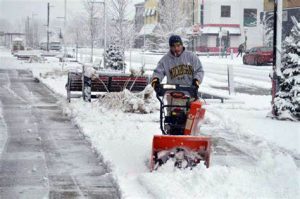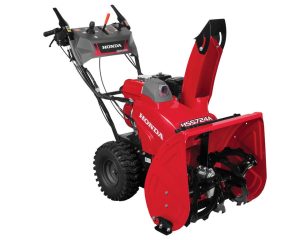6 Reasons Your Snowblower Runs and Then Dies
It’s that time of year again when you work hard to keep your driveway and sidewalk clean by removing snow. Nothing is more frustrating than being in the middle of your snow-blowing project when your snowblower dies.
Getting your snowblower running again is crucial when you’re in the middle of a snowstorm. Without your snowblower, you will be left in a bind and most like have to resort to using a hand shovel.
Most of the time, your snowblower starting and then dying is easily fixed so you can get your job done.
The most common reasons your snowblower may start and then die are:
- Bad fuel
- A dirty carburetor that is unable to regulate the mixture of air and gas provided to the engine
- Too much oil is in the crankcase
- Clogged fuel filter
- Broken fuel cap that is unable to vent
- Dirty spark plug

This post may include affiliate links. Purchases made through these links may provide a commission for us, at no extra cost to you. As an Amazon Associate, we earn from qualifying purchases.
Follow all safety instructions provided in your equipment operator’s manual prior to diagnosing, repairing, or operating.Consult a professional if you don’t have the skills, or knowledge or are not in the condition to perform the repair safely.
Both single-cylinder and twin-cylinder engines will present this problem at some point in their life span. When this happens to you, it may seem like the easiest and most possible solution to your snowblower dying is to buy a new spark plug.
If your snowblower starts then we know it is getting spark. Replacing the spark plugs may not fix anything. Read on to find out more details on the most common problems resulting in your snowblower being able to start, but then just stop running.
Table of Contents
5 Reasons Why Your Snowblower Starts & Dies
1. Bad Fuel in Your Snowblower
Gasoline is usually good for about 30 days and then it begins to break down and fail. The fuel loses its ability to run well and hot because the chemicals that are used in fuel today start to decay and fall apart.
Most types of gasoline available today has ethanol in their makeup. Fuels treated with ethanol tend to collect moisture from the air.
The water can evaporate leaving a residue in the fuel tank that can clog the fuel system. If your fuels are over 30 days old, drain the fuel tank, flush the tank, and fill it with fresh fuel.
- Fuel Stabilizer Additive
You may want to consider adding a fuel stabilizer to your fuel. Mix the stabilizer with the fuel in a fuel can before adding it to your snowblower’s gas tank. This will prevent the new fuel from breaking down quickly.
I like using a product called Sea Foam because it has cleaning agents in it for the engine. Not only is it better for the carburetor, but also for the valve train as well. It also helps keep the carbon down on top of the piston when it is in use. - 2-Cycle Snowblowers
While many snowblowers sold today use 4-cycle engines, you may have a snowblower that uses a 2-cycle engine that requires a fuel and oil mix to be used.2-cycle engines have a single fill port for a gas and oil mix. If you are unsure of the type of engine used in your snowblower or the gas-to-oil mix ratio to be used, refer to your operator’s manual. You may find the fuel-to-oil ratio listed on your fuel cap.
- Ethanol-Free Fuel
You can find recreational fuel at many gas stations. This fuel does cost more, but it does not contain ethanol. Big box stores and small engine retail stores offer cans of non-ethanol 4-cycle fuel along with 2-cycle premixed fuels.- 4-Cycle Engine Fuel: TruFuel 4-Cycle Fuel
- 2-Cycle Engine 40:1 Premix: TruFuel 2-Cycle 40:1 Pre-Blended Fuel
- 2-Cycle Engine 50:1 Premix: TruFuel 2-Cycle 50:1 Pre-Blended Fuel
It’s important to treat fuel obtained from a gas station when fueling from a pump. You never know how old the fuel is so not only is it important to treat it, but I also recommend you get fuel from a busy gas station.
There is no need to treat recreational fuel, but it will not hurt if you do treat it.
For a more in-depth article about the correct fuel for your snowblower read, “This is the Type of Gas Snowblowers Use“.
2. Snowblower Carburetor is Dirty
A dirty snowblower carburetor can be the cause of your snowblower not running. The carburetor is designed to regulate the amount of air with the right amount of fuel to create a combustion.
You will need to check and clean your carburetor if necessary. This may sound complicated, but it really is not. If you are not very mechanically inclined, you should bring your snowblower to a repair center.
If you are mechanically inclined, then read on. If your carburetor is in a condition that is beyond cleaning, you will need to replace it.
12 Steps to Identify and Clean Your Dirty Carburetor
- Spray carb cleaner to minimize carbon buildup. Spray some carb cleaner in the air intake. Start the engine to see if it will run. If your snowblower fires up and still won’t stay running, then we need to get inside the carburetor.
- Gather pliers, screwdrivers, sockets, and ratchets so you don’t destroy parts while taking the carburetor apart.
- Take a photo for reassembly. These days most people have a handy camera on their phones. It’s a very good idea to take a picture of the carburetor so you can refer to it if you don’t remember how to reassemble it after tearing it apart. You will want to make sure you get a photo showing how the linkage and springs go back on the carburetor.
- Remove the throttle cable and choke cable if your snowblower has one.
- Undo the filter housing and nuts or screws that hold the carburetor.
- Slowly remove the springs so you don’t stretch them out too much. You may have to twist the carb a bit to get the springs off. Also, watch the gasket at this point so you don’t tear it. This is the gasket located between the engine block and the carburetor.
- Remove the bottom screw from the float bowl. The float bowl is where gasoline is stored inside the carburetor. It should have gas in it so have a rag ready to catch the gas.
- Remove the bowl being careful to not damage the o-ring around it. Caution: Do not get any carb cleaner or any other chemical on the o-ring. It will stretch out and you won’t be able to reuse it.
- Inspect the stem for clogged holes. This stem hangs down from the center of the carburetor and has holes in it. If these holes get plugged from old fuel it will not draw fuel up to the jet.
If the holds are plugged, take a thick wire to clean them out. It’s easier to see what you’re doing if you use a flashlight. Once you get the holes clean you can rinse them with carb cleaner.
- Inspect the carburetor for hard crusty white buildup. This white buildup is fuel additives including ethanol. You need to try to get as much of the white power material out as you can. It’s nearly impossible to get it all out.
- Reassemble the carburetor now that the carb is clean. Put it back together in the reverse order you took it apart. Remember to refer to the photo you took of the carburetor when reassembling so all parts are reinstalled in the right places.
- Add fresh fuel plus a fuel stabilizer before you start your snowblower. Pour the fuel into the tank and give it a chance to fill the bowl of the carburetor. Start your engine.
If you are starting with a pull cord, give the rope a yank. It may not start on the first pull, but it should start after several pulls and continue to run.
3. Clogged Fuel Filter on a Snowblower
A clogged fuel filter can restrict fuel flow. Moisture can also get into the filter and freeze. To repair this, replace your fuel filter.
4. Too Much Oil Can Cause the Engine to Shut Down
When there is too much engine oil in your snowblower then your engine may smoke, run terribly, and eventually may shut down. Too much engine oil can get up to your spark plug, into your cylinder, and hydro lock your engine.
- 2-cycle engine: Running more oil in the gas-to-oil mix required by your engine must be corrected. Drain the fuel and fill it with the correct gas-to-oil mix.
- 4-cycle engine: Correct the engine oil level by draining a little oil.
5. Broken SnowBlower Fuel Cap
Fuel caps are designed to be vented. If the vent is clogged or the cap is broken your engine may die because it cannot get fuel. If your cap won’t vent, a vacuum is formed in the tank which then doesn’t provide fuel.
Remove the cap and start your snowblower to check to see if your cap may be broken. Replace with a new cap if you are able to start your snowblower with the cap loosened allowing it to vent.
6. Bad Spark Plug in a Snowblower
Your spark plug may have created enough spark to start your snowblower, but it doesn’t allow it to continue to run. A dirty or damaged spark plug can cause the plug to fire intermittently.
Check the spark plug’s condition and replace it if you find it is very dirty or damaged. If you find it is a little dirty, you can attempt to clean it with a wire brush.
Because of the importance of this small component to the Craftsman’s performance, I choose to replace it with a new plug.
Why Doesn’t My Snowblower Have an Air Filter?
Snowblowers do not use air filters because they are designed to be used in the winter season when dusty conditions are not present.
Using an air filter for snow blowing is not often seen because the likelihood of ice buildup on the filter will clog the filter and restrict airflow required by the engine.






